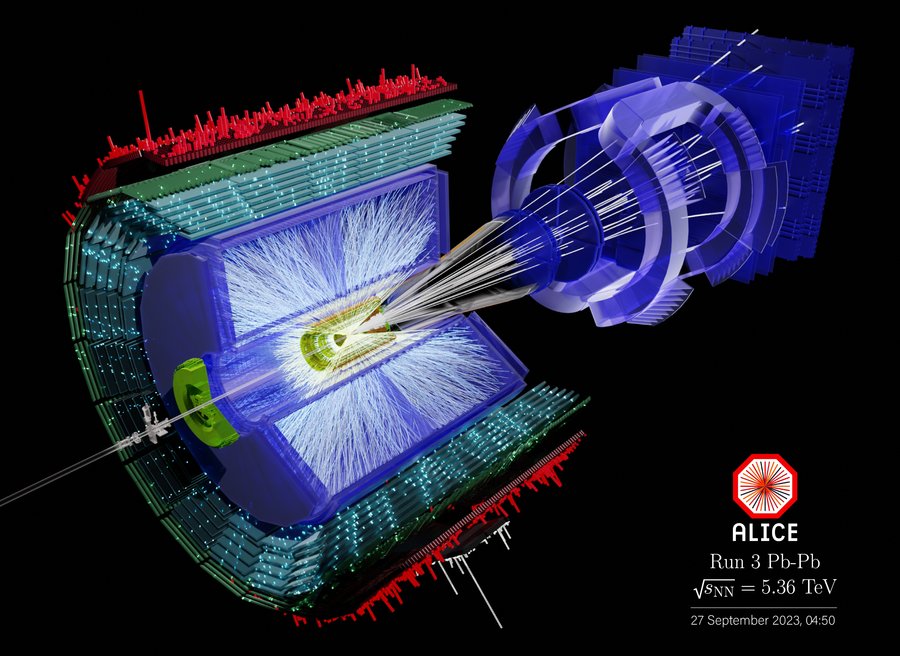LHC lead-ion collision run complete for 2023 — ALICE detector in operation with crucial upgrades by GSI/FAIR
16.11.2023 |
Completing the first heavy-ion run in five years, it was the turn of lead ion beams to be accelerated and to deliver collisions to the experiments. The nuclei collided with an increased energy of 5.36 TeV per nucleon pair (compared to 5.02 TeV previously) at a rate of up to 50 kHz — more than an order of magnitude larger than what was achieved before. The efforts included the restart of the upgraded ALICE experiment, which has successfully taken data. GSI/FAIR have been involved in the design, construction and operation of ALICE from the start and delivered crucial upgrades for the detector. The primary physics goal of this run was the study of the elusive state of matter known as quark-gluon plasma, that is believed to have filled the Universe up to a millionth of a second after the Big Bang and can be recreated in the laboratory in heavy-ion collisions.
Quark-gluon plasma is a state of matter made of free quarks (particles that make up hadrons such as the proton and the neutron) and gluons (carriers of the strong interaction, which hold the quarks together inside the hadrons). In all but the most extreme conditions, quarks cannot exist individually and are bound inside hadrons. In heavy-ion collisions however, hundreds of protons and neutrons collide, forming a system with such density and temperature that a tiny fireball of quark-gluon plasma forms, the hottest substance known to exist. Inside this fireball quarks and gluons can move around freely for a split-second, until the plasma expands and cools down, turning back into hadrons.
Studies of quark-gluon plasma in this heavy-ion run focus on rare processes such as the production of heavy quarks, quarkonium states, real and virtual photons and heavy nuclear states. The increased number of collisions is expected to allow measurement of the temperature of the plasma using thermal radiation in the form of photons and electron-positron pairs. Hydrodynamic properties of the near-perfect liquid state of matter will thus be measured in greater detail and “tomography” using particles such as the charm or beauty quarks that are produced in the initial phase of the collision, pass through the plasma and are detected afterwards. All these measurements will be far more precise than before. Data taking for the run is complete and a total integrated luminosity of 2.16 per nanobarn could be reached.
For the purpose of performing these studies with the LHC’s improved lead-ion beam, significant upgrades have been implemented in ALICE’s collision detection and analysis. ALICE is now using an entirely new mode of data processing storing all collisions without selection, resulting in up to 100 times more collisions being recorded per second. In addition, its track reconstruction efficiency and precision have increased due to the installation of new subsystems and upgrades of existing ones.
GSI/FAIR has taken part in the development of new measurement instruments, in particular in the design and construction of the ALICE Time Projection Chamber (TPC), and in the ALICE scientific program from the very beginning. Also, GSI/FAIR contributed significantly to the development of the new readout chambers. A substantial part of the chambers was built in collaboration between the ALICE research department and the detector laboratory at GSI/FAIR. Staff from both departments also assisted in the insertion of the chambers on site at CERN.
The ALICE upgrade work at GSI/FAIR, completed in budget and in time, is crucial to fully exploit the collision rate of 50 kHz provided by the LHC. It was – in addition to the GSI/FAIR base funding – also financially supported by the Helmholtz Association together with other upgrades of LHC experiments.
Likewise, the IT department of GSI/FAIR made key contributions to the new software systems. The GSI/FAIR computer center remains an integral part of the computer network for data analysis of the ALICE experiment. The expertise from the upgrades is also relevant for the future operation of FAIR. For example, continuous data streams will also be read out at the Compressed Baryonic Matter (CBM) experiment. (CP)
Further information
- ALICE at GSI/FAIR
- ALICE Collaboration













